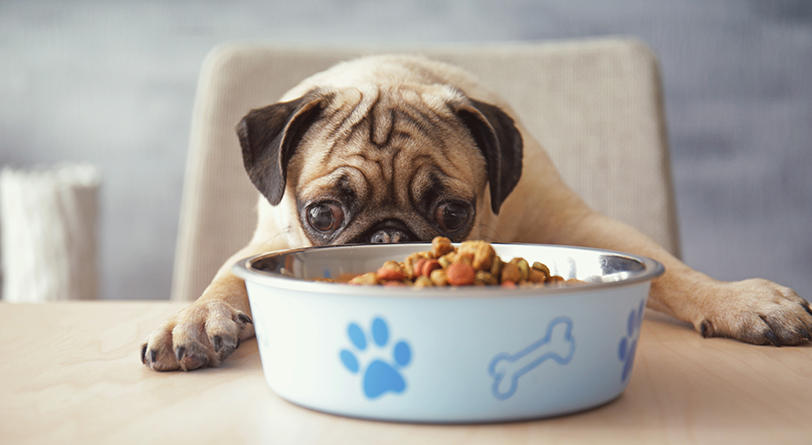The Flexible Packaging Association (FPA) partnered with PTIS, LLC to perform a streamlined life cycle assessment (LCA) to compare flexible packaging options for the pet food sector with those of other comparative packaging formats to better understand the environmental impacts. The pet products were evaluated across a range of package formats, including pet food, flea collars, dog treats, and dog dental sticks.
The LCA’s purpose is to use the results as an educational tool to better understand the environmental impacts of the various package format options. The packages selected represent a range of product options, comparing various packaging formats with the flexible packaging option. It is important to remember that the environmental attributes of an LCA are only one consideration when selecting a package format. A package developer must also take a holistic perspective around consumer usage, brand equity, convenience, product protection/shelf life, and distribution environment along with the LCA attributes when selecting an appropriate package format.
The assessment considered only the primary packaging because FPA/PTIS did not have access to secondary packaging or pallet load information for each product. Each product sample used in the assessment was purchased at a pet supply or mass merchandiser retailer. The packages were then deconstructed, and each component was weighed. For the flexible packaging options, an outside expert was utilized to determine the most likely construction of the package. The density of each material and the weight allocated to each material were then determined and used for the assessment.
Streamlined LCA tool
EcoImpact-COMPASS®, a widely accepted tool within the packaging community, was used for the LCA package comparison. It is known as a streamlined LCA because it uses industry average data rather than inputs specific to a particular company, and it’s much quicker than a full LCA. The EcoImpact-COMPASS® tool also uses data from ecoinvent, the U.S. Life Cycle Inventory Database (part of the National Renewable Energy Laboratory), and other LCA databases that are widely used. EcoImpact-COMPASS® allows for a cradle-to-grave boundary because it can also incorporate transportation and end-of-life (recycling or landfill) impacts. The tool is administered and updated regularly by software provider, Trayak.
Dog treats comparison—primary package
Dog treats are sold in various package formats, and for this comparison, three of the most common formats were used: a stand-up pouch, a carton, and a polyethylene terephthalate (PET) jar. The stand-up pouch was used as the standard with which other options were compared.
From a fossil fuel usage perspective, the stand-up pouch resulted in a reduction in fossil fuel use of 23% compared with the carton, and 425% for the PET jar—mostly driven by the weight of the jar. The stand-up pouch weighed under 12g (for 12 oz. of product), while the carton weighed nearly 60g (for 19 oz. of product), and the PET jar came in at 119g (for 25 oz. of product). As such, the stand-up pouch is much more efficient in the amount of product it holds when compared with the other formats.
Pet food comparison—primary package
Sold in a variety of packaging formats, five of the most common formats for pet food packaging were used for the comparison:
- Foil-based retort pouch for dog food,
- Clear retort pouch for cat food,
- Dog food in a thermoformed cup with foil lid stock,
- Cat food in a thermoformed cup with a clear lid stock and wrap-around paperboard sleeve, and
- Aluminum can (pet food cans can be made of aluminum, stainless steel, or tinplate).
The dog food foil retort pouch was used as the standard with which the other options were compared.
The water consumption metric considers the relative water remaining per area in a watershed. This is meant to acknowledge the impacts of water consumption in areas with high water scarcity with a factor utilized for areas where scarcity is a major concern. This attribute is measured in cubic meters of water.
For this usage metric, the two-pouch options came in with the lowest amount of water consumed among the options evaluated. The cat food pouch was approximately 24% higher in water usage than the dog food pouch, largely due to the pouch containing less food (2.47 oz. vs. 3 oz.), while utilizing the same 3.2g of material. The aluminum can was considerably higher (+160%) in water usage due to the amount of water consumption needed in making bauxite to produce aluminum in the production process.
Dog dental sticks comparison—primary package
Dog dental sticks are a common treat and health product used by dog owners and are sold in various package formats. For this comparison, three of the most common formats were used: a stand-up pouch, a rigid tub, and a corrugated case. The stand-up pouch was used as the standard with which other options were compared.
The global warming potential (GWP) metric is the greenhouse gas emissions in CO2 equivalents for the different package formats.
The stand-up pouch resulted in lower emissions than the other package formats used for the comparison and was driven by the material efficiency of the stand-up pouch—the rigid tub resulted in over 200% more GWP than the pouch.
The stand-up pouch and rigid tub formats consist entirely of plastic materials, but the stand-up pouch has much higher material efficiency.
The corrugated box resulted in an approximate 35% increase in GWP over the stand-up pouch, despite the higher weight and less efficient material usage. Being paper-based, the corrugated box does not have as much CO2 allocated in the materials phase as may be expected for a package format that weighs over three times as much per amount of product. This was likely due to the use of biomass for energy in the material production phase.
For more information
Visit www.flexpack.org to view the full report.
Dani Diehlmann is FPA vice president, communications.
